BUICK CENTURY 1994 Manual Online
Manufacturer: BUICK, Model Year: 1994, Model line: CENTURY, Model: BUICK CENTURY 1994Pages: 308, PDF Size: 16.3 MB
Page 81 of 308
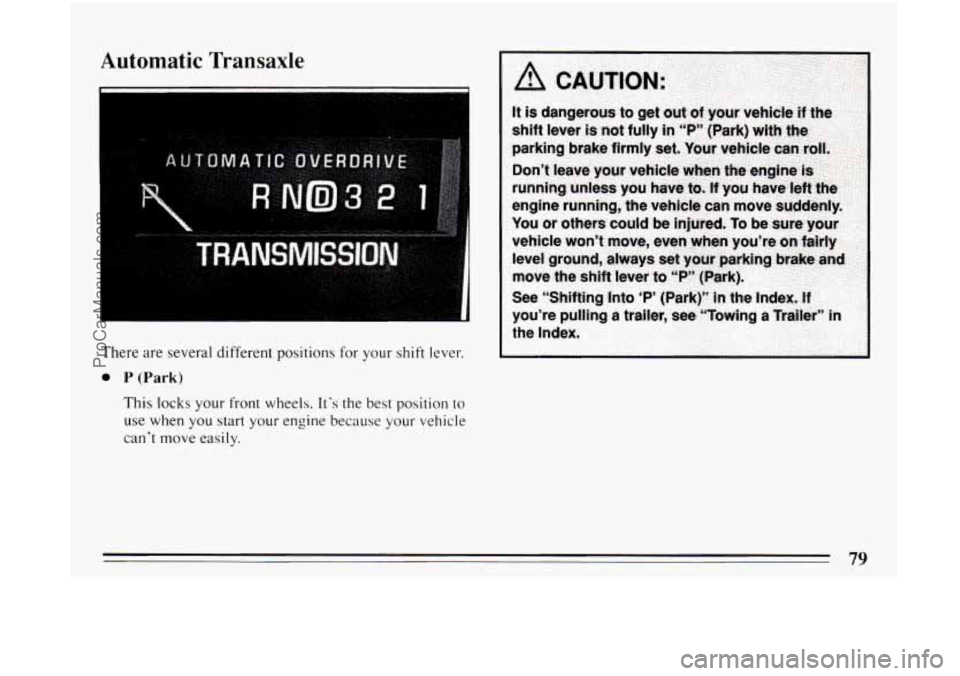
Automatic Transaxle
I
There are several different positions for your shift lever.
0 P (Park)
This locks your front wheels. It's the best position to
use when you start your engine because your vehicle
can't move easily.
79
ProCarManuals.com
Page 82 of 308
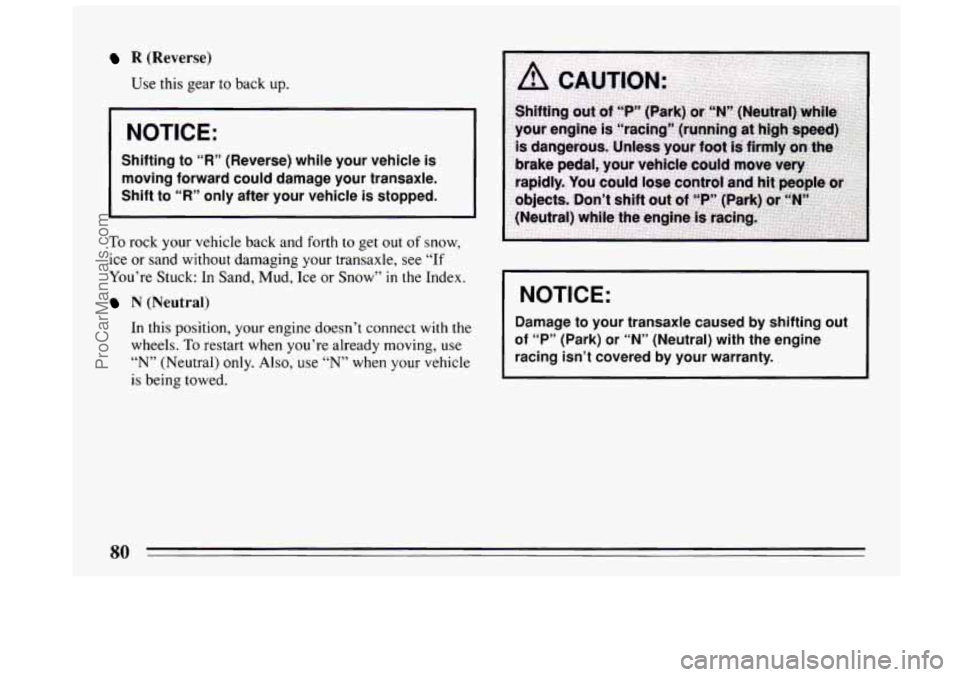
R (Reverse)
Use this gear to back up.
I
I NOTICE:
Shifting to “R” (Reverse) while your vehicle is
moving forward could damage your transaxle.
Shift to
“R” only after your vehicle is stopped.
To rock your vehicle back and forth to get out of snow,
ice or sand without damaging your transaxle, see “If
You’re Stuck: In Sand, Mud, Ice
or Snow” in the Index.
N (Neutral)
In this position, your engine doesn’t connect with the
wheels. To restart when you’re already moving, use
“N” (Neutral) only. Also, use “N” when your vehicle
is being towed.
I NOTICE:
Damage to your transaxle caused by shifting out
of
“P” (Park) or “N” (Neutral) with the engine
racing isn’t covered by your warranty.
80
ProCarManuals.com
Page 83 of 308
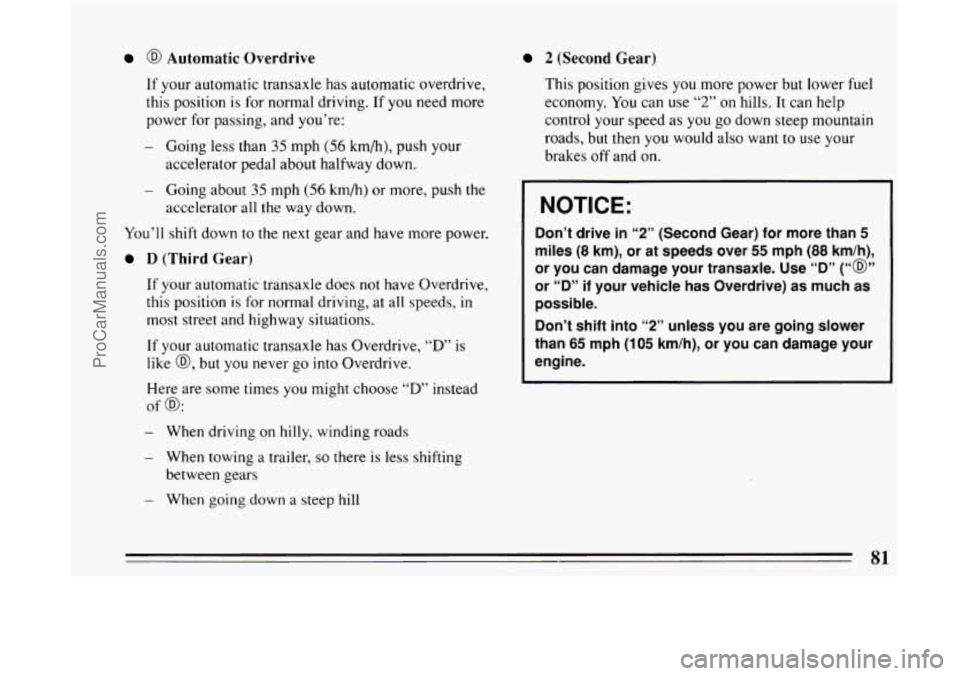
@ Automatic Overdrive
If your automatic transaxle has automatic overdrive,
this position is for normal driving.
If you need more
power for passing, and you’re:
- Going less than 35 mph (56 km/h), push your
accelerator pedal about halfway down.
accelerator all
the way down.
- Going about 35 mph (56 km/h) or more, push the
You’ll shift down to the next gear and have more power.
D (Third Gear)
If your automatic transaxle does not have Overdrive,
this position is for normal driving, at all speeds,
in
most street and highway situations.
If your automatic transaxle has Overdrive,
“D” is
like
@, but you never go into Overdrive.
Here are some times
you might choose “D” instead
of
03:
- When driving on hilly, winding roads
- When towing a trailer, so there is less shifting
- When going down a steep hill
between gears
2 (Second
Gear)
This position gives you more power but lower fuel
economy.
You can use “2” on hills. It can help
control your speed as you go down steep mountain
roads, but then
you would also want to use your
brakes off and
on.
I NOTICE:
Don’t drive in “2” (Second Gear) for more than 5
miles (8 km), or at speeds over 55 mph (88 km/h),
or you can damage your transaxle. Use “D”
(‘@’’
or “D” if your vehicle has Overdrive) as much as
possible.
Don’t shift into
“2” unless you are going slower
than
65 mph (1 05 km/h), or you can damage your
engine.
81
ProCarManuals.com
Page 84 of 308
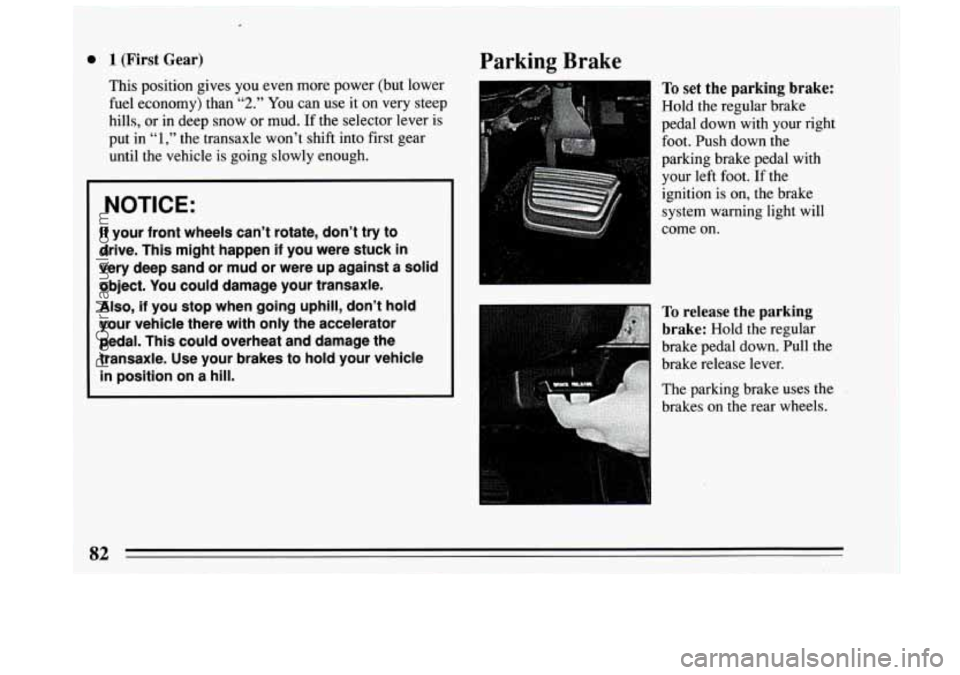
c
0 1 (First Gear)
This position gives you even more power (but lower
fuel economy) than
“2.” You can use it on very steep
hills, or in deep snow or mud. If the selector lever is
put in
“1,” the transaxle won’t shift into first gear
until the vehicle
is going slowly enough.
NOTICE:
If your front wheels can’t rotate, don’t try to
drive. This might happen if you were stuck
in
very deep sand or mud or were up against a solid
object. You could damage your transaxle.
Also, if you stop when going uphill, don’t hold
your vehicle there with only the accelerator
pedal. This could overheat and damage the
transaxle. Use your brakes to hold your vehicle
in position on a hill.
Parking Brake
To set the parking brake:
Hold the regular brake
pedal down with your right
foot. Push down the
parking brake pedal with
your left foot.
If the
ignition is on, the brake
system warning light will
come on.
To release the parking
brake:
Hold the regular
brake pedal down. Pull the
brake release lever.
ProCarManuals.com
Page 85 of 308
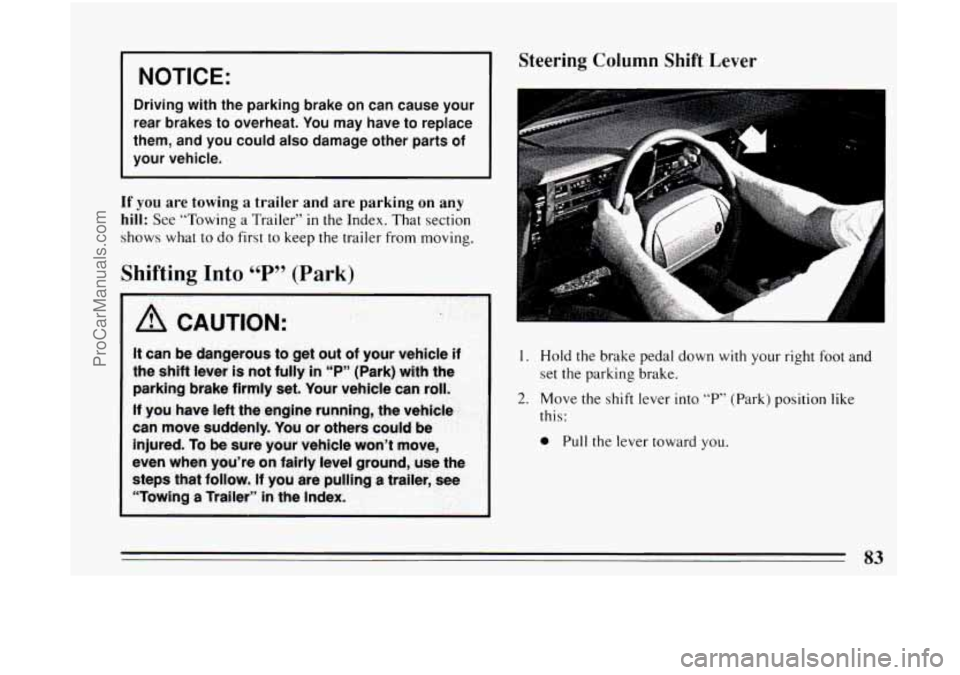
I NOTICE:
Driving with the parking brake on can cause your
rear brakes
to overheat. You may have to replace
them, and you could also damage other parts
of
your vehicle.
If you are towing a trailer and are parking on any
hill:
See “Towing a Trailer” in the Index. That section
shows what to
do first to keep the trailer from moving.
Shifting Into ‘‘P” (Park)
A CAUTION:
Steering Column Shift Lever
1. Hold the brake pedal down with your right foot and
set the parking brake.
2. Move the shift lever into “P” (Park) position like
this:
0 Pull the lever toward you.
83
ProCarManuals.com
Page 86 of 308
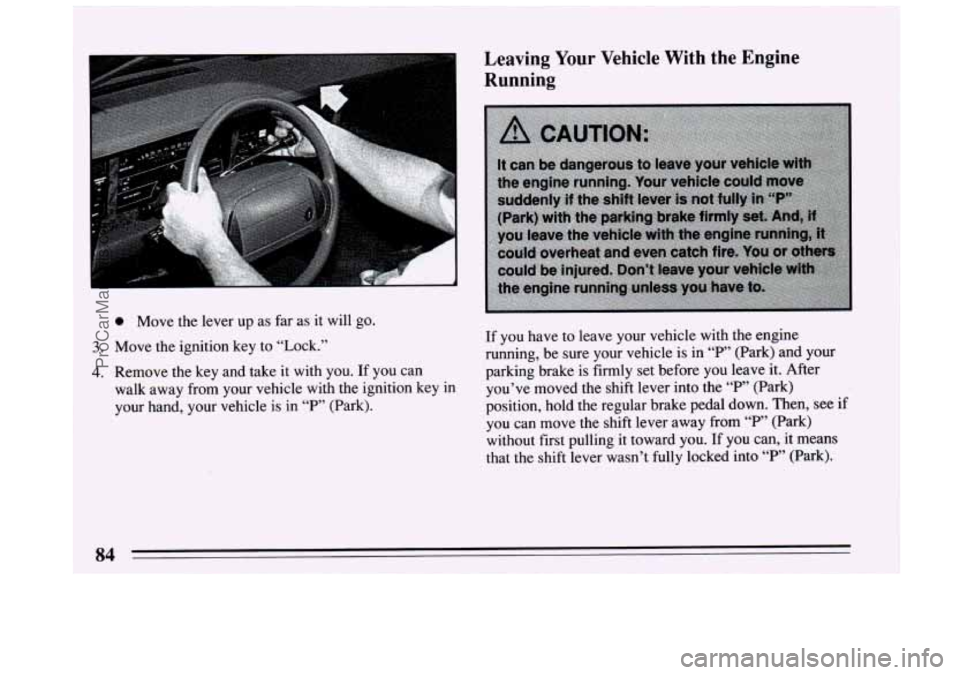
0 Move the lever up as far as it will go.
3. Move the ignition key to “Lock.”
4. Remove the key and take it with you. If you can
walk away from your vehicle with the ignition key in
your hand, your vehicle is in
“P’, (Park).
Leaving Your Vehicle With the Engine
Running
If you have to leave your vehicle with the engine
running, be sure your vehicle
is in “P’, (Park) and your
‘parking brake is firmly set before you leave it. After
you’ve moved the shift lever into the
“P,’ (Park)
position, hold the regular brake pedal down. Then, see if
you can move the shift lever away
from “P” (Park)
without first pulling it toward you. If you can, it means
that the shift lever wasn’t fully locked into “P” (Park).
ProCarManuals.com
Page 87 of 308
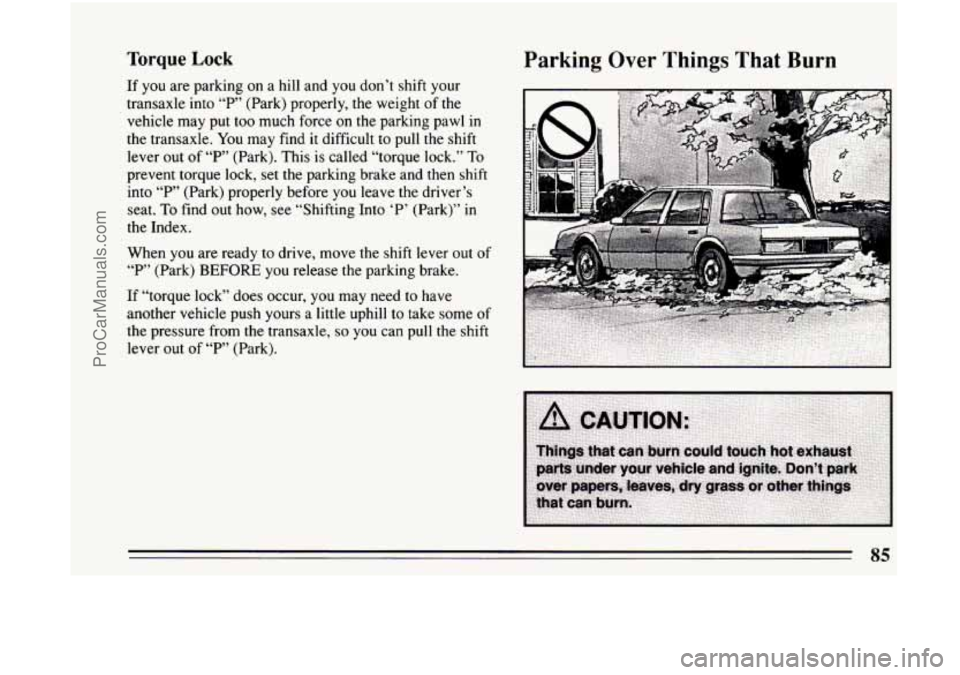
Torque Lock
If you are parking on a hill and you don’t shift your
transaxle into
“P’ (Park) properly, the weight of the
vehicle may put too much force on the parking pawl
in
the transaxle. You may find it difficult to pull the shift
lever out
of “P’ (Park). This is called “torque lock.” To
prevent torque lock, set the parking brake and then shift
into “P” (Park) properly before
you leave the driver’s
seat.
To find out how, see “Shifting Into ‘P’ (Park)” in
the Index.
When you are ready
to drive, move the shift lever out of
“P’ (Park) BEFORE you release the parking brake.
If “torque lock” does occur, you may need to have
another vehicle push yours a little uphill to take some
of
the pressure from the transaxle, so you can pull the shift
lever out of “P” (Park).
Parking Over Things That Burn
85
ProCarManuals.com
Page 88 of 308
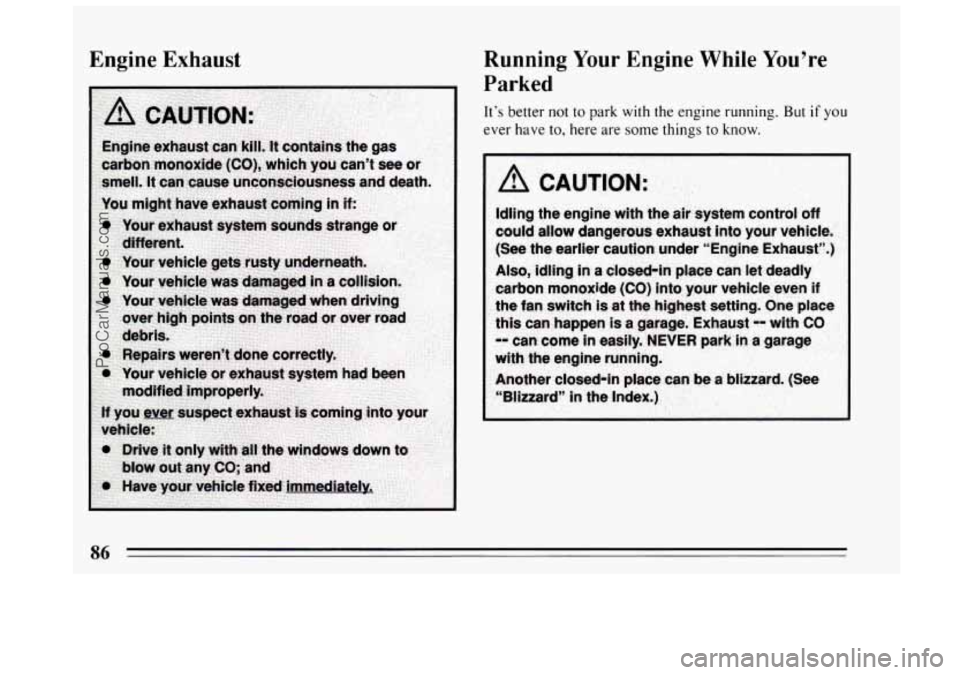
Engine Exhaust Running Your Engine While You’re
Parked
It’s better not to park with the engine running. But if you
ever have to, here are some things to know.
I A CAUTION:
86
ProCarManuals.com
Page 89 of 308
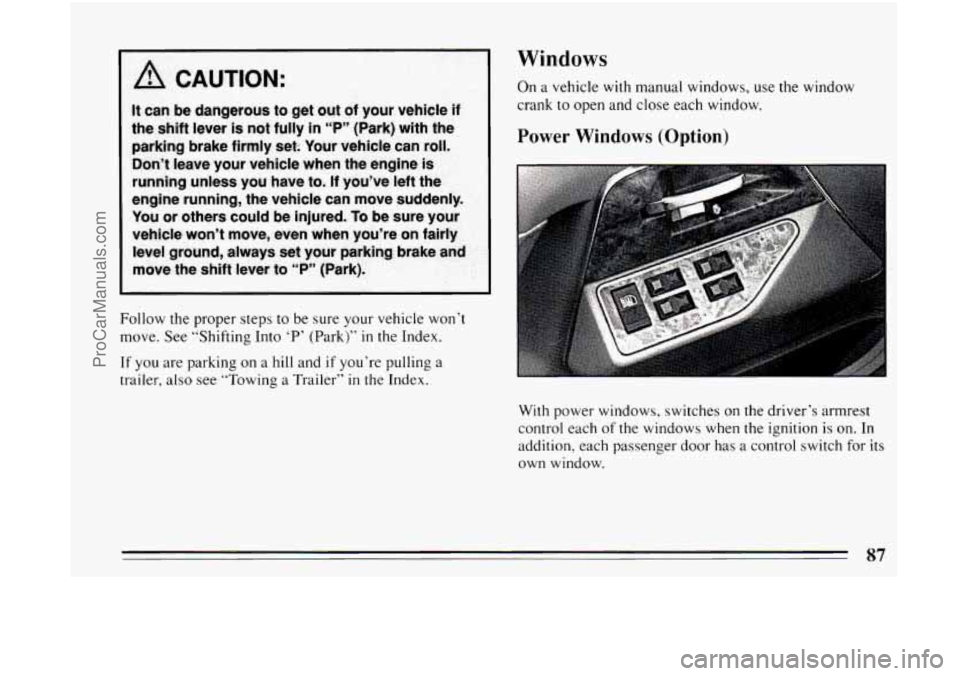
Follow the proper steps to be sure your vehicle won’t
move. See “Shifting Into
‘P’ (Park)” in the Index.
If you are parking on a hill and if you’re pulling a
trailer,
also see “Towing a Trailer” in the Index.
Windows
On a vehicle with manual windows, use the window
crank to open and close
each window.
Power Windows (Option)
With power windows, switches on the driver’s armrest
control each
of the windows when the ignition is on. In
addition, each passenger door has
a control switch for its
own window.
87
ProCarManuals.com
Page 90 of 308
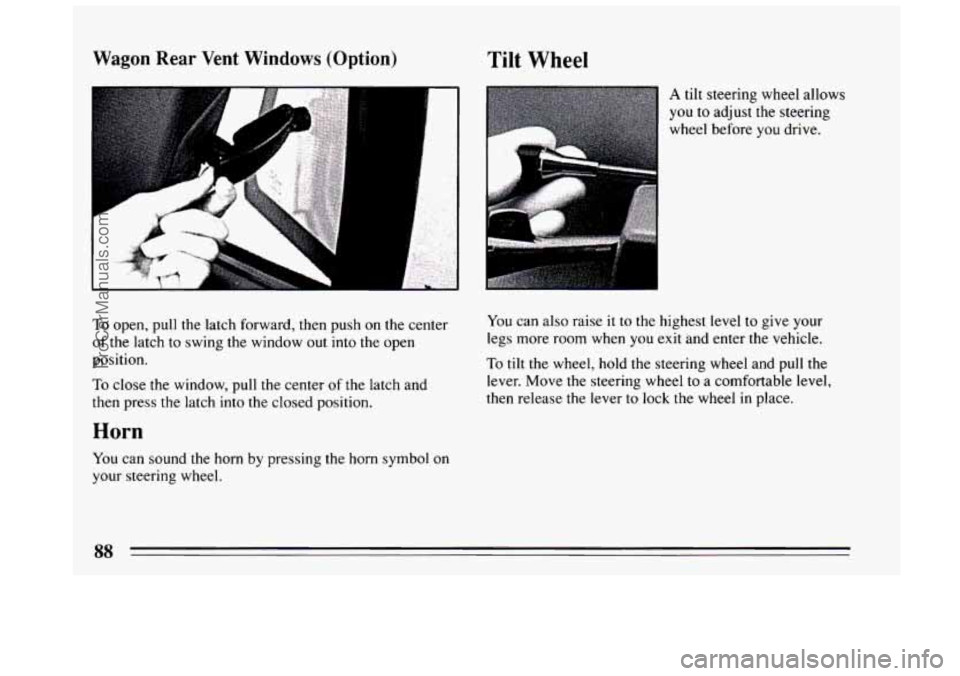
Wagon Rear Vent Windows (Option)
To open, pull the latch forward, then push on the center
of the latch to swing the window out into the open
position.
To close the window, pull the center of the latch and
then press the latch into the closed position.
Horn
You can sound the horn by pressing the horn symbol on
your steering wheel.
Tilt Wheel
A tilt steering wheel allows
you to adjust the steering
wheel before
you drive.
You can also raise it to the highest level to give y6ur
legs more room when you exit and enter the vehicle.
To tilt the wheel, hold the steering wheel and pull the
lever. Move the steering wheel
to a comfortable level,
then release the lever to lock the wheel in place.
88
ProCarManuals.com